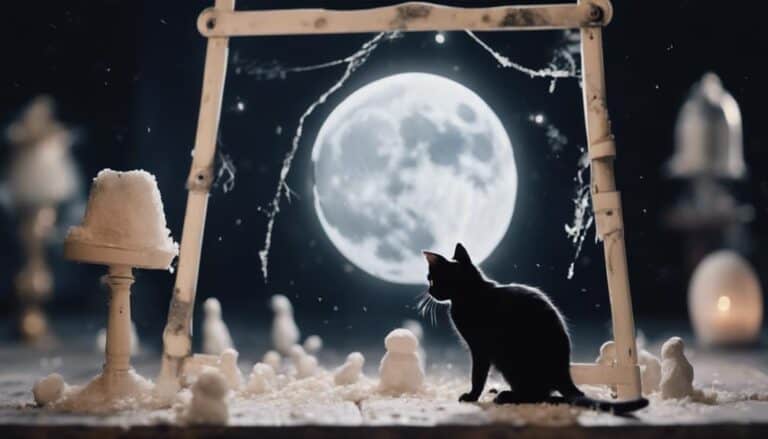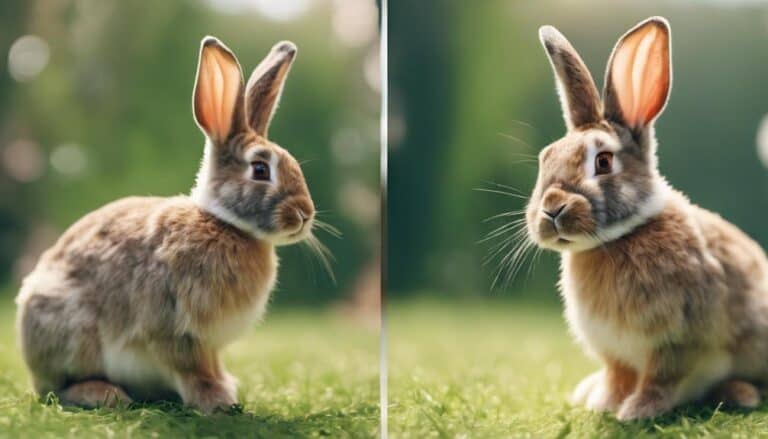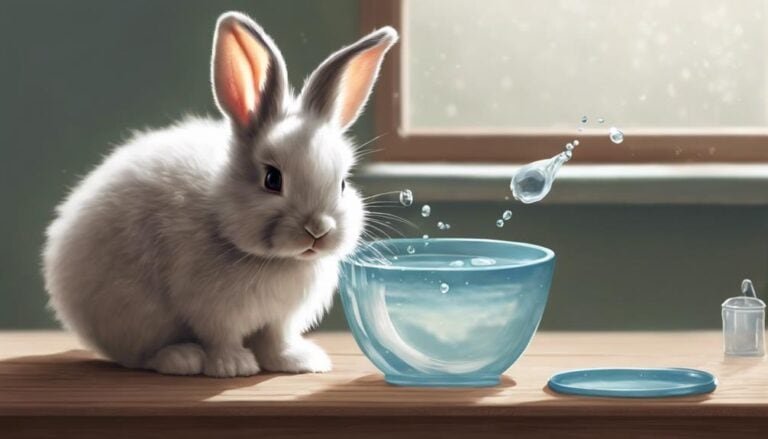You've probably heard the saying, 'An ounce of prevention is worth a pound of cure.'
But did you know that bunnies can also be susceptible to pink eye? Imagine the adorable fluffiness of your bunny paired with the discomfort of this eye condition.
What are the specific symptoms you should watch out for, and how can you ensure your bunny's vision stays crystal clear?
Let's explore this intriguing topic further, starting with understanding the risks and early signs of pink eye in bunnies.
Contents
- 1 Key Takeaways
- 2 What Is Pink Eye in Bunnies?
- 3 Causes of Pink Eye in Bunnies
- 4 Symptoms of Pink Eye in Bunnies
- 5 Diagnosing Pink Eye in Bunnies
- 6 Treatment for Pink Eye in Bunnies
- 7 Preventing Pink Eye in Bunnies
- 8 Pink Eye Vs. Other Eye Conditions in Bunnies
- 9 When to Seek Vet Care for Pink Eye in Bunnies
- 10 Tips for Caring for a Bunny With Pink Eye
- 11 Frequently Asked Questions
- 12 Can Pink Eye in Rabbits be Related to Gender Changes?
- 13 Conclusion
Key Takeaways
- Bunnies can get pink eye from bacterial, viral, parasitic infections, foreign bodies, or allergies.
- Symptoms include eye discharge, inflamed tear ducts, behavioral changes, pink membranes, and potential sight loss.
- Diagnose and treat promptly with vet guidance using antibiotic eye drops and anti-inflammatory medication.
- Prevent pink eye by providing a balanced diet, regular eye checks, avoiding irritants, maintaining cleanliness, and dental care.
What Is Pink Eye in Bunnies?
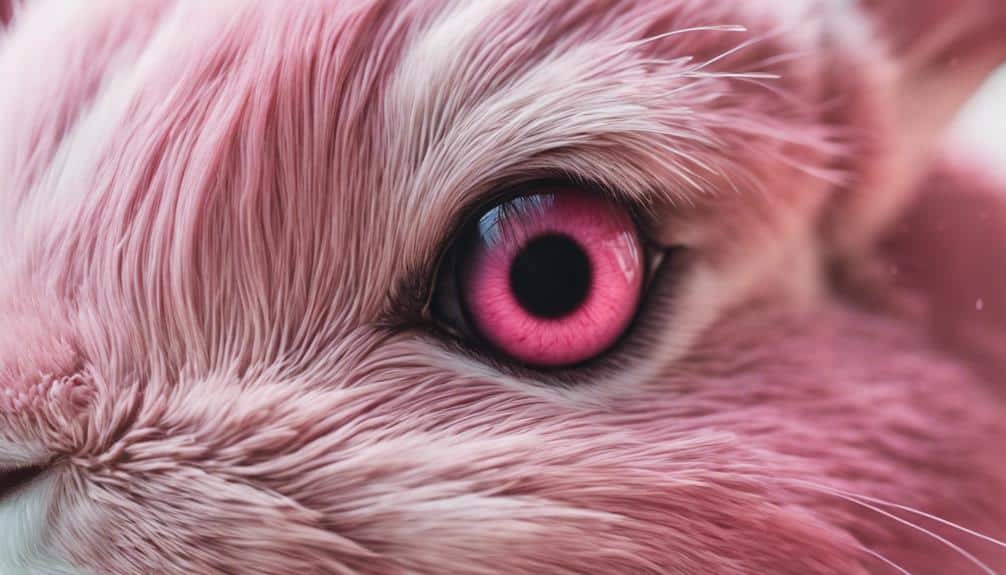
Pink eye in bunnies, also known as conjunctivitis, is characterized by inflammation of the eye surface and inner eyelids. This eye infection presents with symptoms such as pink and inflamed membranes, discharge, and potential discomfort in affected bunnies. Conjunctivitis in bunnies can be caused by various factors, including bacterial infections, viral infections like myxomatosis, parasites, foreign bodies, and allergies.
When dealing with pink eye in bunnies, prompt veterinary care is essential for proper diagnosis and treatment to prevent complications and maintain best eye health. Treatment options for conjunctivitis in bunnies may include antibiotic eye drops or ointments, anti-inflammatory medications, and supportive care to alleviate discomfort.
It's vital to address pink eye promptly, as the condition can progress rapidly, leading to severe eye damage, potential sight loss, and even spreading to other parts of the bunny's body. By understanding the nature of conjunctivitis and seeking timely veterinary intervention, you can ensure the best possible outcome for your bunny's eye health.
Causes of Pink Eye in Bunnies
When considering the causes of conjunctivitis in bunnies, bacterial infections are a prominent factor to be aware of. This condition can also be triggered by viral infections like myxomatosis and parasitic infections such as Encephalitozoon cuniculi. Additionally, the presence of foreign bodies like seeds or allergies to dusty hay can lead to pink eye in bunnies.
Here are the key causes summarized:
- Bacterial Infections: Bacteria such as Pasteurella multocida can easily infect a bunny's eyes, causing inflammation of the conjunctiva and leading to pink eye.
- Viral Infections: Viruses like myxomatosis are highly contagious among rabbits and can result in conjunctivitis, affecting the bunny's eyes.
- Foreign Bodies: Introduction of foreign objects like seeds or hay particles into the eyes can irritate the sensitive tissues, potentially causing conjunctivitis in bunnies.
Understanding these causes is critical in preventing and managing pink eye in bunnies effectively.
Symptoms of Pink Eye in Bunnies
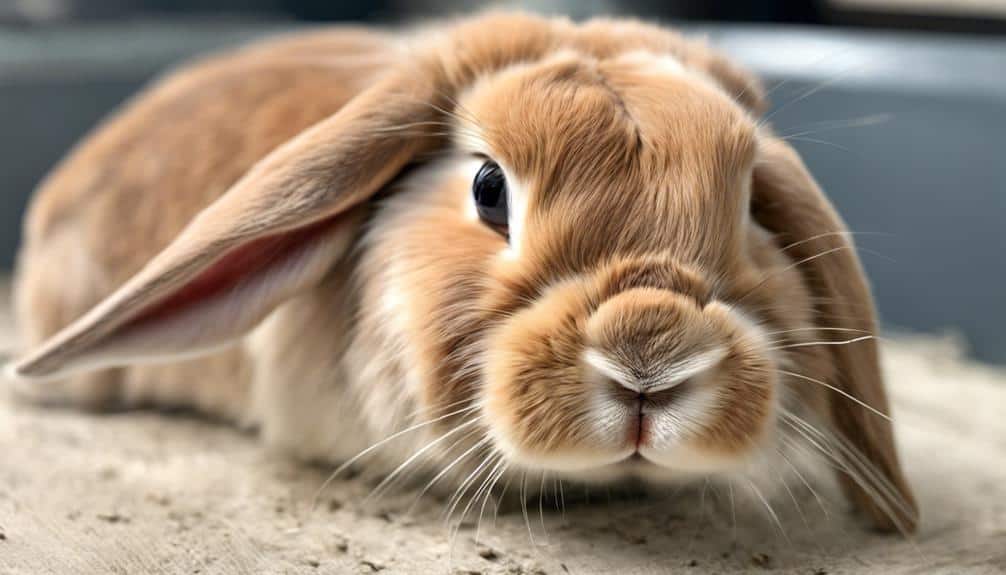
At the onset of conjunctivitis in bunnies, noticeable symptoms typically manifest in the form of pink and inflamed membranes in the eyes. You may observe discharge in the corners of the eye or notice fur matting or loss on the lower eyelids. Additionally, be attentive to behavioral changes in your bunny such as hiding, lethargy, and a reduced appetite, as these could indicate pink eye.
The condition can affect one or both eyes, leading to red, inflamed skin around the eyes. If you notice any of these symptoms in your bunny, it's important to seek prompt veterinary care. A vet can provide a proper diagnosis and recommend the most effective treatment to prevent sight loss and further complications.
Diagnosing Pink Eye in Bunnies
To effectively diagnose pink eye in bunnies, observe for symptoms like redness, discharge, and squinting.
A veterinary examination will help pinpoint the cause and guide the appropriate treatment.
Early detection and intervention are essential in managing pink eye and ensuring your bunny's well-being.
Symptoms of Pink Eye
Symptoms of pink eye in bunnies, known as conjunctivitis, manifest with pink and inflamed eye membranes. When observing your bunny for signs of pink eye, watch out for the following:
- Discharge from the eye: Look for any unusual discharge, especially in the corners of the eye.
- Inflamed tear ducts: Check for redness and swelling around the tear duct area, indicating potential conjunctivitis.
- Behavioral changes: Keep an eye out for changes like hiding, lethargy, or a reduced appetite, as these can be signs of discomfort or pain related to pink eye.
If you notice these symptoms, it's essential to seek prompt veterinary care to make sure your bunny receives proper eye care and prevent any potential sight loss.
Treatment Options
When diagnosing pink eye in bunnies, a veterinarian will conduct a thorough eye examination to confirm the presence of conjunctivitis. Once diagnosed, treatment options for pink eye in bunnies may involve antibiotic eye drops to combat any bacterial infections present in the eye. Additionally, anti-inflammatory medication can help reduce inflammation and discomfort in the affected eye.
It's also essential to practice gentle eye cleaning to remove any discharge or debris that may exacerbate the condition. Prompt veterinary care is vital to address pink eye in bunnies effectively and prevent potential complications or the spread of the infection. By following the veterinarian's recommendations for treatment, you can help your bunny recover from pink eye and safeguard their eye health.
Treatment for Pink Eye in Bunnies
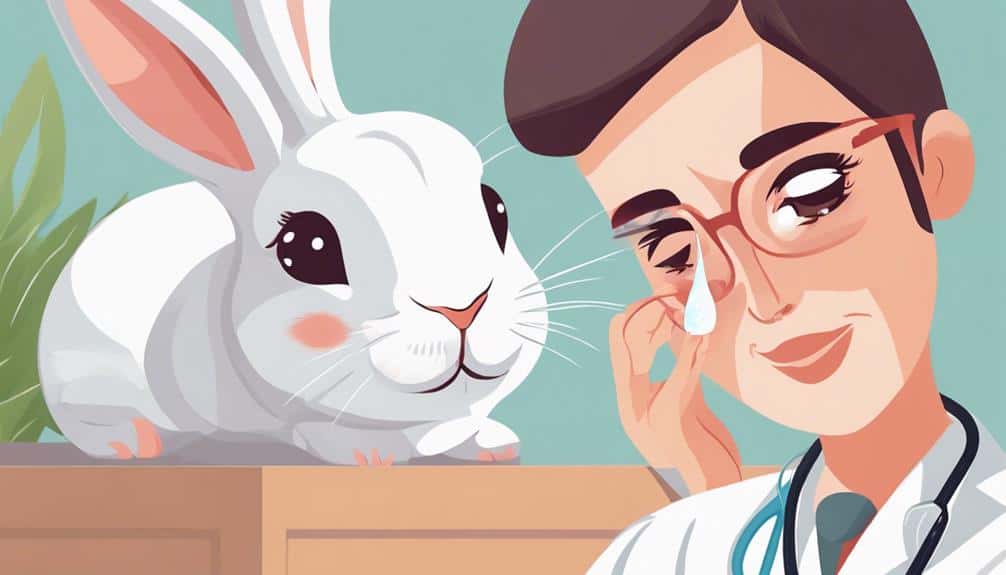
When addressing pink eye in bunnies, prompt veterinary attention is vital to prevent complications.
Treatment may involve gentle eye cleaning, thorough examinations, and targeted identification of the infection.
Timely and proper care is essential to safeguard your bunny's eye health and overall well-being.
Bunny Pink Eye Symptoms
If your bunny displays pink and inflamed membranes with discharge, immediate veterinary care is essential for treating pink eye to prevent further complications. Bunny pink eye symptoms can vary but may include:
- Pink and Inflamed Membranes: The conjunctiva, inner eyelids, and surrounding areas may appear pink or red due to inflammation.
- Discharge: Your bunny may have discharge from the eye, which can be clear, white, yellow, or green in color.
- Potential Sight Loss: In severe cases, pink eye can lead to sight loss if left untreated.
Early intervention is vital to address these symptoms effectively and prevent any lasting damage to your bunny's eyes.
Bunny Pink Eye Care
To effectively treat pink eye in bunnies, prompt veterinary care is essential for minimizing eye damage and ensuring a successful recovery process. When caring for a bunny with pink eye, essential cleaning of the affected eye is vital to remove any discharge and prevent further irritation.
Your veterinarian may recommend specific eye drops or ointments to help reduce inflammation and treat the underlying cause of the pink eye. Additionally, dental examinations are important as dental issues can contribute to eye problems in rabbits.
Clean living spaces and a high-fiber diet can also aid in preventing pink eye in bunnies. Remember, regular eye checks and prompt intervention are key to maintaining your rabbit's eye health and overall well-being.
Preventing Pink Eye in Bunnies
Maintain a clean living environment for your bunny to prevent bacterial infections that can lead to pink eye. To safeguard your bunny's eye health and overall well-being, follow these essential tips:
- Provide a Balanced Diet: Offer a diet rich in fiber to promote good dental health. Dental disease can lead to eye infections in bunnies, making a vital diet for preventing pink eye.
- Regular Eye Checks: Monitor your bunny's eyes regularly for any signs of redness, discharge, or irritation. Early detection of pink eye can help in prompt treatment and prevent complications.
- Avoid Irritants: Refrain from using dusty hay or bedding, as these can irritate your bunny's eyes and potentially lead to pink eye. Opt for clean, dust-free alternatives to keep your bunny's eyes healthy.
Pink Eye Vs. Other Eye Conditions in Bunnies
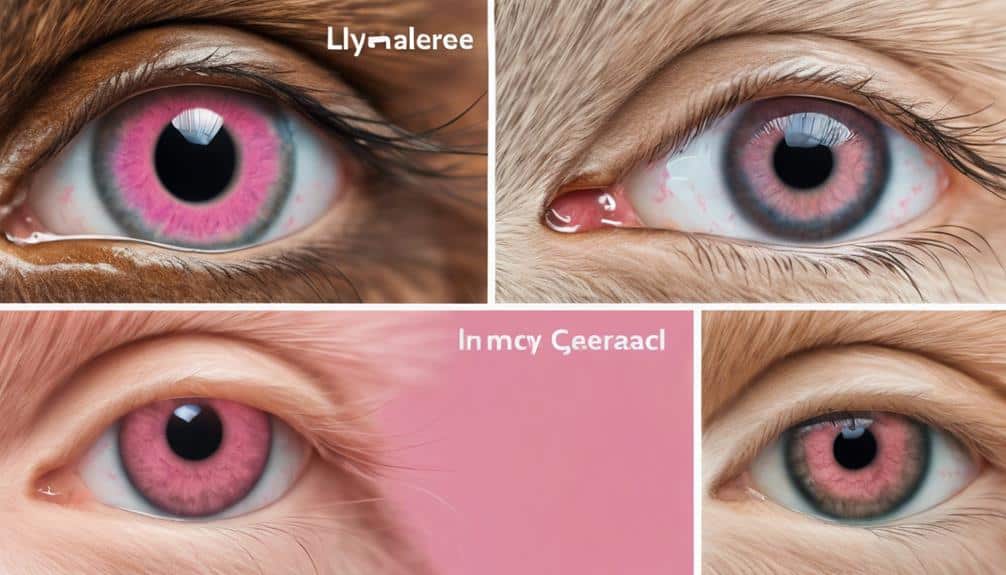
When distinguishing between pink eye and other eye conditions in bunnies, understanding the key differences in symptoms and causes is essential for timely and effective treatment. Pink eye, also known as conjunctivitis, is characterized by inflammation of the eye membranes in bunnies. While pink eye shares similarities with other eye conditions, certain distinctions can help you identify and address the issue promptly. Here is a comparison table to highlight the variations between pink eye and other common eye conditions in bunnies:
| Criteria | Pink Eye (Conjunctivitis) | Other Eye Conditions |
|---|---|---|
| Inflammation | Present | Variable |
| Causes | Bacterial, viral, etc. | Trauma, infections, etc. |
| Treatment | Antibiotics, eye drops | Varies based on cause |
| Contagious | Highly contagious | Not always contagious |
| Symptoms | Redness, discharge, discomfort | Varies |
Understanding these differences can aid in the proper identification and treatment of eye conditions in bunnies. Remember that prompt veterinary care is crucial, especially if you suspect pink eye due to its contagious nature and potential for severe complications.
When to Seek Vet Care for Pink Eye in Bunnies
Seek immediate veterinary care if your bunny displays symptoms of pink eye such as redness, inflammation, and discharge.
To guarantee the well-being of your bunny's eyes, here's when you should seek vet care for pink eye:
- Persistent Symptoms: If your bunny's pink eye symptoms persist or worsen despite initial home care measures, it's crucial to consult a veterinarian promptly to prevent any potential complications.
- Changes in Behavior: Keep an eye on your bunny's behavior; if you notice signs of discomfort, such as rubbing the eyes frequently or avoiding light, seeking vet care is advisable to address the underlying issue causing the inflammation.
- Preventive Measures: Even if the symptoms seem mild, seeking vet care for pink eye in its early stages can help prevent the condition from progressing and recurring, ensuring your bunny's eye health is properly managed.
Tips for Caring for a Bunny With Pink Eye
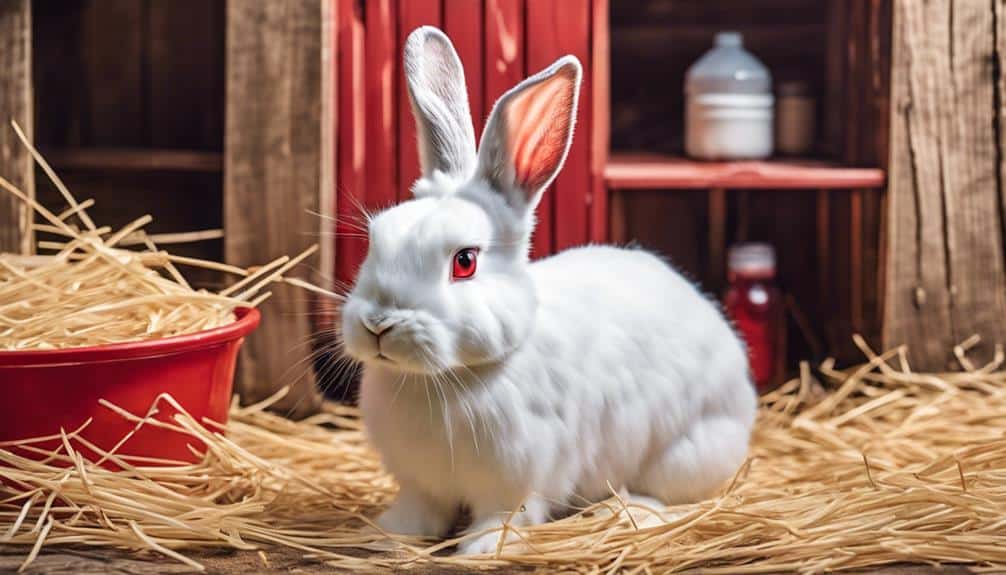
To properly care for a bunny with pink eye, guarantee timely veterinary attention if symptoms persist or worsen despite initial home care measures. Pink eye, also known as conjunctivitis, in bunnies can lead to serious complications if left untreated. Your vet should be consulted as soon as possible to determine the appropriate treatment plan. They may prescribe eye drops to help alleviate the inflammation and infection. It's important to administer any prescribed medication diligently and follow the vet's instructions closely.
In addition to medication, gentle cleaning of your bunny's eyes may be necessary to remove any discharge or debris. Be cautious not to irritate the eyes further during this process. Monitoring your bunny's condition closely is essential, as pink eye can impact their sight and overall well-being if not managed promptly. Your vet may also examine the tear ducts to ensure they're functioning correctly and to rule out any underlying issues contributing to the pink eye.
Frequently Asked Questions
How Do You Treat Pink Eye in Rabbits?
When treating pink eye in rabbits, seek immediate veterinary advice. Gentle cleaning with cooled boiled water aids rabbit eye care. Avoid home remedies without professional guidance. Prevention tips include regular dental exams to prevent issues contributing to conjunctivitis.
Can Rabbits Have Pink Eyes?
When it comes to rabbit behavior, diet, grooming, and habitats, staying vigilant is key. Keep an eye out for any signs of pink eye in your bunnies. Early detection and swift veterinary care can prevent serious consequences.
Can Humans Get Eye Infections From Rabbits?
You can contract eye infections from rabbits through direct contact with their secretions. Preventive measures like proper handwashing can reduce risks. Common symptoms include redness, swelling, discharge, and irritation. Prompt medical attention is crucial for treatment.
Can Animals Get Pink Eye From You?
Animals like bunnies can't get pink eye from you. However, they may develop similar eye issues from different causes. Maintain preventive care, watch for symptoms, and seek veterinary help promptly to guarantee your pet's eye health.
Can Pink Eye in Rabbits be Related to Gender Changes?
There is no scientific evidence to suggest that pink eye in rabbits has any correlation with gender changes. According to a recent rabbits changing gender article, the likelihood of pink eye is not influenced by gender. It is important to seek proper veterinary care to treat pink eye in rabbits regardless of their gender.
Conclusion
To sum up, when it comes to bunnies and pink eye, it's important to hop to it and seek veterinary care at the first sign of trouble. Just like a delicate flower, a bunny's eyes are precious and must be protected.
By promptly addressing symptoms and following proper treatment protocols, you can make certain your furry friend's vision remains as clear as a spring morning.
So, don't turn a blind eye to pink eye in bunnies – take action and safeguard their sight.

